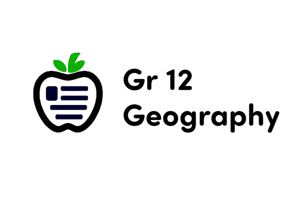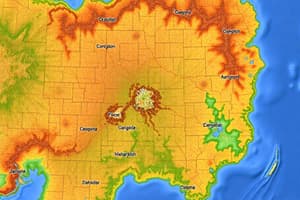Podcast
Questions and Answers
What is the primary function of GIS?
What is the primary function of GIS?
- To display spatial data in a map format
- To enable the analysis of spatial data and their attributes for decision support (correct)
- To perform mathematical operations on spatial data
- To collect and store spatial data
What is the purpose of reclassification in spatial analysis?
What is the purpose of reclassification in spatial analysis?
- To overlay more than two layers
- To rebuild the spatial data and the topology
- To retrieve attribute data without altering the existing data
- To reclassify attribute data by dissolving a part of the boundaries and merging into new reclassified polygons (correct)
What is the type of operator used in the conditional statement in a query?
What is the type of operator used in the conditional statement in a query?
- Algebraic
- Arithmetic
- Relational (correct)
- Logical
What is the purpose of the SELECT clause in a query?
What is the purpose of the SELECT clause in a query?
What is the result of overlaying more than two layers in spatial analysis?
What is the result of overlaying more than two layers in spatial analysis?
What is the primary purpose of connectivity analysis?
What is the primary purpose of connectivity analysis?
What is the main objective of spatial analysis in GIS?
What is the main objective of spatial analysis in GIS?
Which of the following is an example of a relational operator used in a query?
Which of the following is an example of a relational operator used in a query?
What is the outcome of the Coverage Rebuilding process in spatial analysis?
What is the outcome of the Coverage Rebuilding process in spatial analysis?
What is the purpose of the FROM clause in a query?
What is the purpose of the FROM clause in a query?
What is the primary function of a query in spatial analysis?
What is the primary function of a query in spatial analysis?
What is the main application of overlaying more than two layers in spatial analysis?
What is the main application of overlaying more than two layers in spatial analysis?
Flashcards are hidden until you start studying
Study Notes
GIS Function and Spatial Analysis
- The primary function of GIS is to enable spatial data analysis and its attributes for decision support.
- Spatial analysis involves examining locations, attributes, and relationships of features in spatial data using overlay and other analytical techniques to address a question or gain useful knowledge.
Spatial Analysis Categories
- Query: retrieval of attribute data without altering the existing data through arithmetic and logical operations.
- Reclassification: reclassification of attribute data by dissolving a part of the boundaries and merging into new reclassified polygons.
- Coverage Rebuilding: rebuilding of spatial data and topology by "update", "erase", "clip", "split", "join", or "append" operations.
- Overlay: overlaying of more than two layers, including rebuilding topology of merged points, lines, and polygons, and operations on merged attributes for suitability studies, risk management, and potential evaluation.
- Connectivity Analysis: analysis of connectivity between points, lines, and polygons in terms of distance, area, travel time, and optimum paths.
Query Specifications
- A query is used to retrieve attribute data without altering the existing data according to specifications given by the operator.
- The specifications include three items:
- SELECT: attribute name(s)
- FROM: table
- WHERE: condition statement
- The conditional statement is represented by three types of operators:
- Relational: >, <, =, etc.
- Logical: AND, OR, NOT, etc.
- Arithmetic: +, -, *, /, etc.
GIS Function and Spatial Analysis
- The primary function of GIS is to enable spatial data analysis and its attributes for decision support.
- Spatial analysis involves examining locations, attributes, and relationships of features in spatial data using overlay and other analytical techniques to address a question or gain useful knowledge.
Spatial Analysis Categories
- Query: retrieval of attribute data without altering the existing data through arithmetic and logical operations.
- Reclassification: reclassification of attribute data by dissolving a part of the boundaries and merging into new reclassified polygons.
- Coverage Rebuilding: rebuilding of spatial data and topology by "update", "erase", "clip", "split", "join", or "append" operations.
- Overlay: overlaying of more than two layers, including rebuilding topology of merged points, lines, and polygons, and operations on merged attributes for suitability studies, risk management, and potential evaluation.
- Connectivity Analysis: analysis of connectivity between points, lines, and polygons in terms of distance, area, travel time, and optimum paths.
Query Specifications
- A query is used to retrieve attribute data without altering the existing data according to specifications given by the operator.
- The specifications include three items:
- SELECT: attribute name(s)
- FROM: table
- WHERE: condition statement
- The conditional statement is represented by three types of operators:
- Relational: >, <, =, etc.
- Logical: AND, OR, NOT, etc.
- Arithmetic: +, -, *, /, etc.
Studying That Suits You
Use AI to generate personalized quizzes and flashcards to suit your learning preferences.




